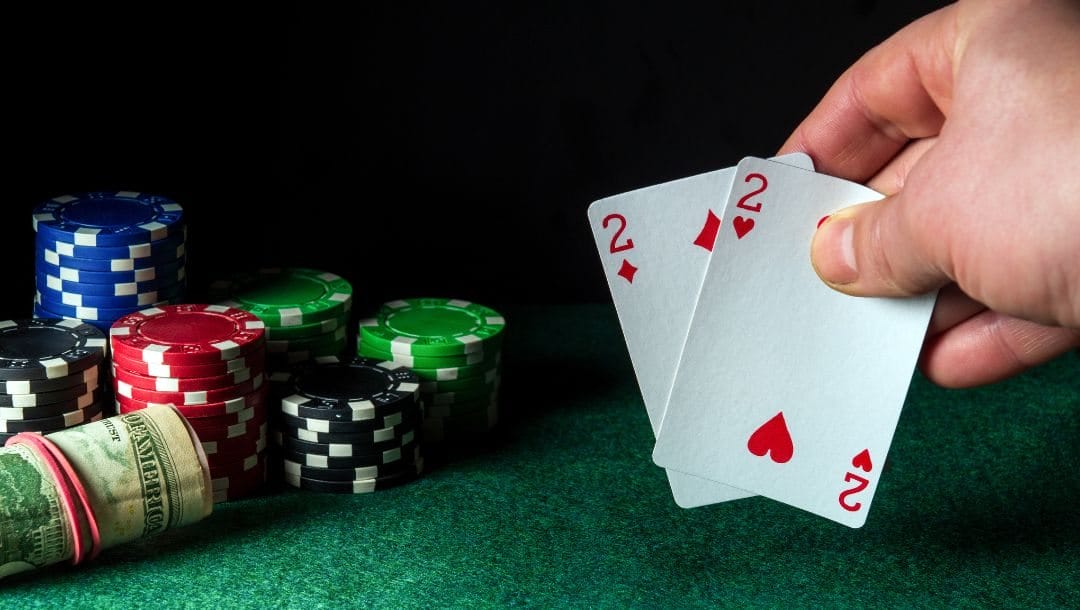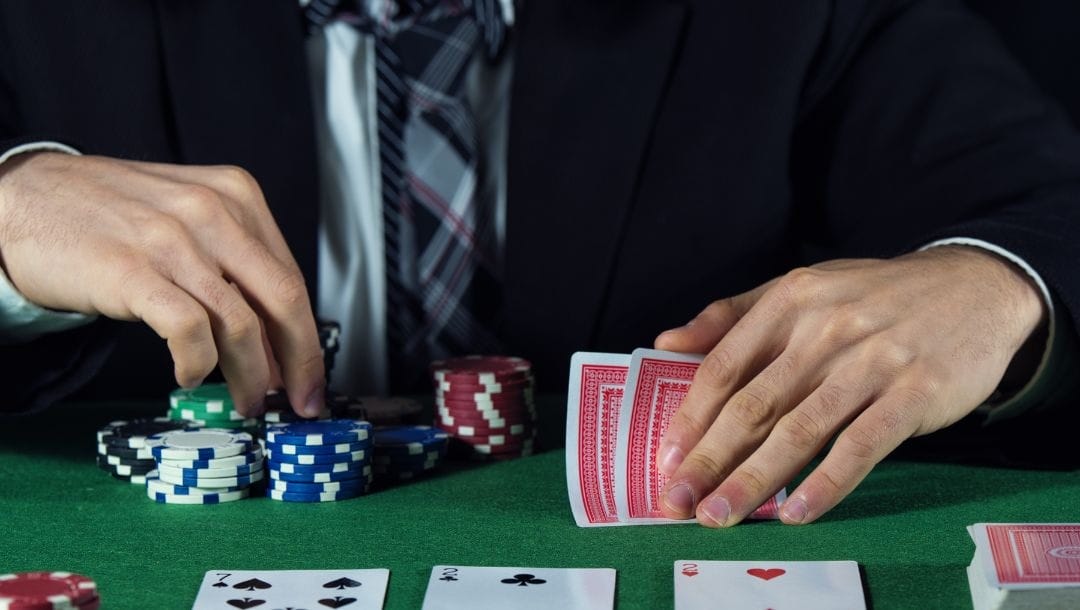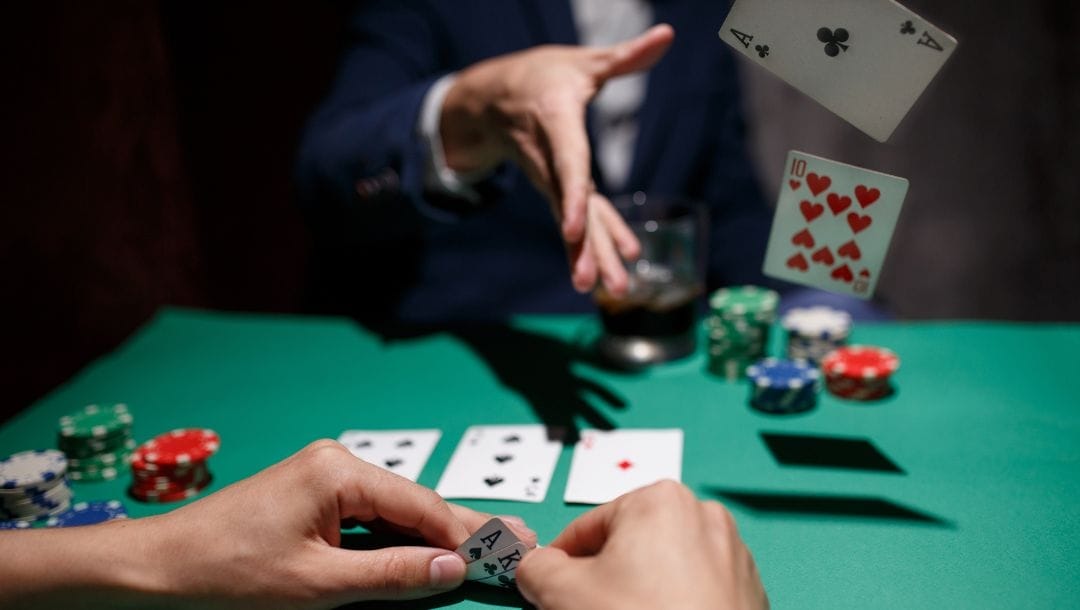To many, folding in poker is like waving a white flag and giving up on a particular hand. But knowing when to fold in poker is more than just an emotional reaction to a bad hand; it forms part of a much broader long-term strategy. Some players fold too often, and others too rarely. The sweet spot can be quite difficult to find, even for a few pros who have made some pretty awful folds.
Whether you’re playing for fun with a group of friends or competing in high-stakes poker tournaments, it’s important to understand what folding means, when to fold in poker, and when not to. Here is a beginner’s guide to folding correctly in poker.
What Is Folding in Poker?
In its most basic form, folding is when a player tosses their cards into the discard pile and calls it quits for that round.
Picture this: you’re sitting at the table and assessing your cards. You decide it’s time to fold. You slide your cards face-down on the table or give them a little push toward the dealer, signaling your surrender.
To the novice player, folding can feel like a devastating blow. But to the seasoned professional, it’s all part of the larger strategy.
Folding Etiquette
While you may feel defeated playing poker with bad hands, you do need to resist the urge to toss those cards into the muck right away. Knowing the etiquette of how to fold in poker is an essential part of the game.
Can you fold out of hand in poker? Absolutely not. Jumping the gun and folding out of turn is taboo when playing at a table. To avoid disapproving looks from your fellow players, wait your turn before acting. When you fold too early, you’re giving away valuable information to those who still have the chance to act. They’ll know there’s one less player in the mix, affecting their decision to call, raise or fold.
It’s a little different in online poker, where you can program your fold action when you see your cards. But if you’re at a live table, exercise some patience. Wait until it’s your turn to make the move.
When you do decide to fold, try not to get too clever. Place the cards face-down and slide them forward, making it easy for the dealer to sweep them away. You may even announce your fold verbally, saying something like “I fold,” to make it crystal clear.
Another thing to remember is not to expose your folding hands when throwing them in. You may incur the wrath of the dealer, who will issue you with a warning and may even deal you out if you continue doing it.
The Hero Fold
There is an exception when it comes to exposing your hand when folding, and that is after all the opponents have made their plays. Known as the “hero fold,” you may show your cards after the river card has been dealt, and it’s down to you and one other opponent who goes all-in. At this point, folding and showing your hand is considered a courtesy to let the opponent know how close the game actually was.
How Do You Know When To Fold in Poker?
Now that you know how to fold, let’s discuss the factors that influence your decision. Knowing when to fold isn’t as simple as going on intuition. Great players use math, psychology, and skill to make a decision. Here are a few things to keep in mind when deciding to fold.
Opponent Betting Ranges
It’s really important to analyze your opponent’s potential hand before making any decisions. By carefully observing their betting range and past actions, you can gain valuable insights into their likely choices. This is why learning about range balancing in poker is so important.
Pay attention to how they’ve played their hands so far, including the hands they’ve folded, the bets they’ve made, and any bluff attempts they’ve made. This information will help you make informed judgments and anticipate their next moves.
Pot Odds, Equity, and MDF
Considering pot odds is a crucial element in your decision-making process. Before folding, it’s important to evaluate the pot odds in relation to your opponent’s bet size. Having a grasp of your pot odds will assist you in determining the percentage of the time you need to make the right call.
For instance, if your opponent makes a bet that’s equal to the size of the pot, you would need to be correct approximately 33% of the time to come out on top. Understanding these odds allows you to make informed choices about whether to continue in the game or fold. Most players use pot odds to calculate the equity or chance of winning they need in their hand against their opponent’s range to make the call profitable.
What is fold equity in poker? Put simply, fold equity is a subjective calculated percentage of the likelihood that you can make an opposing player fold. The principle is straightforward: fold if your hand isn’t a profitable call. This seems like a sound approach.
In most cases, however, you need to do more than just an equity calculation. You may need to call even if your hands don’t meet the equity requirements. This is called minimum defense frequency (MDF) and is usually used when playing against players you don’t know. MDF is calculated when you divide the amount you need to call by the size of the pot and then multiply the result by 100 to get a percentage.
For example, say your opponent bets $50 into a $50 pot, which translates to $50/$100 x 100 = 50%. In this case, you would have to defend 50% of your range against the bet to avoid exploitation.
That said, there is far more to reading the game than math, and you should rely more heavily on your other skills to determine your folding frequency than just MDF.
Your Own Hand Strength

Knowing the strength of your own hand is critical when deciding whether to fold or continue playing. You want to avoid folding strong hands that have a high potential to win. However, it’s important to be aware that skilled opponents can exploit you if you consistently play every strong hand.
On the other hand, recognizing a weak hand early and folding before the flop can save you from potential losses. Players who adopt a game theory optimal (GTO) approach can master this skill by following proven strategies and making decisions based on mathematical principles.
Reading Your Opponents
Just like in any poker game, it’s essential to have a deep understanding of your opponents. By studying their playing style and habits, you can tailor your strategy accordingly. Pay close attention to their tells, those subtle cues that reveal their intentions. Exploiting these tells can give you a significant advantage.
Being able to recognize when your opponent is bluffing or playing a strong hand can help you make better decisions and avoid difficult situations. It’s all about using your observation skills to gain an edge at the poker table.
How Often Should You Fold?
The rule of thumb with folding frequency seems to be 30% of the time on average. This seems obvious, given that the more you fold, the less opportunity you have to win. However, that percentage ranges significantly depending on when you’re folding — preflop, postflop, or on the turn.
What’s really important is to understand that finding the right balance is absolutely critical.
Folding Too Often
The reality is that most players start out playing hyper-aggressively and seldom fold, calling most hands. This blind aggression is inevitably exploited by more experienced players, which results in a pendulum swing to folding too much. This may seem like a solid defensive style, preserving your stack for stronger hands. However, it opens you up to several risks. You might be folding too often if you notice the following patterns in your game.
Losing Equity
In poker, every hand holds some degree of equity against your opponent’s betting range, even if it’s not particularly strong. When you choose to fold, you relinquish that equity, allowing your opponent to claim a larger share of the pot than they should.
Waiting for a substantial equity advantage isn’t always feasible. Even if your hand only has 25–30% equity, it can often be enough to justify continuing in the game, depending on the bet size and your opponent’s betting range.
By recognizing and considering the equity your hand holds, you can make more informed choices and avoid unnecessarily giving up potential winnings. So, don’t be too quick to fold if your hand has a reasonable chance of success based on its equity.
You Become a Target
If you only choose to stay in the game when you have a strong hand, you’ll end up folding most of the time. Other players at the table will catch on to this pattern and start bluffing you more often. By consistently waiting for strong hands, you’ll fall victim to bluffing and lose out on winning many pots, which can significantly decrease your overall success rate.
You Give the Opponent Impetus
Confidence plays a crucial role in poker. It empowers players to make bold moves and trust their judgment, even in the face of uncertainty. If you frequently fold against your opponent, you inadvertently boost their confidence, making it more challenging for you to navigate the game and hand them the initiative.
Folding Preflop
It may seem counter-intuitive, but roughly 40–50% of your hands will not be worth pursuing in most preflop situations. Additionally, as you move further away from the dealer button (BTN), increasing the number of hands you fold becomes even more significant.
For instance, in a 9-handed game, you’ll typically only raise about 15% of your hands from the under-the-gun (UTG) position, resulting in approximately 85% of the hands dealt in that position being folded. This disciplined approach helps you make more informed decisions and focus on playing stronger hands with higher winning potential postflop.
Folding Postflop
Determining when to fold becomes more challenging at postflop since there are no pre-established ranges to rely on. Instead, there are three major factors you need to consider to assess whether folding is the appropriate choice: your opponent’s range, the strength of your hand, and the pot odds you are presented with.
Beyond the MDF approach mentioned earlier, here are a few scenarios that signal you should be cautious calling and consider folding:
- When confronted with a substantial bet from a tight player known for rarely bluffing.
- When encountering a triple-barrel bet on the river from a cautious opponent.
- When a previously passive player suddenly adopts an aggressive betting strategy.
- When a recreational player excessively overbets the pot.
Of course, there are times when your hand is just too weak, and the strength of your opponent’s betting range won’t matter (unless your opponent is a compulsive bluffer).
Consider folding the following hands to fold in poker:
- When a pocket pair is accompanied by two or more overcards on the flop.
- When facing a significant bet with only a bottom pair.
- When holding a draw but lacking the appropriate odds to justify a call.
- When holding a hand that lacks both a pair and any drawing potential.
Other Common Folding Mistakes

Regardless of the variant of poker you’re playing, there are some common mistakes you can make when folding.
Folding Too Quickly
Impatient players may fold prematurely without fully evaluating the situation. They may give up on a hand too early, not considering the possibility of improving their hand or bluffing their opponents.
Ignoring Position
Folding hands based on their perceived strength solely, without considering their position at the table, can be a mistake. A weaker hand in an advantageous position can still have potential value and should not be folded too hastily.
Overvaluing Small Losses
Some players tend to fold too easily after losing a small amount of chips or suffering a minor setback. This mindset can lead to missed opportunities for recovery and growth in the game.
Emotional Folding
Allowing emotions like anger or frustration to dictate folding decisions can be detrimental and lead to playing on tilt. Making impulsive folds based on emotions rather than rational analysis can lead to unnecessary losses.
Misreading Opponents
Incorrectly assessing the strength of opponents’ hands or their bluffing tendencies can lead to unnecessary folds. It is essential to carefully observe and analyze opponents’ actions to make accurate folding decisions.
Falling Into Patterns
Establishing predictable folding patterns can make a player vulnerable to exploitation. Skilled opponents can identify these patterns and adjust their strategies accordingly, taking advantage of the player’s tendencies to fold certain hands.
BetMGM Is a Winning Hand
Register with BetMGM to hone your poker skills. Learn advanced techniques before taking on some of the best online poker players around. Not your thing? BetMGM hosts many other online casino games, from online Bingo to jackpot slots and baccarat. Play the game of your choice with BetMGM.










